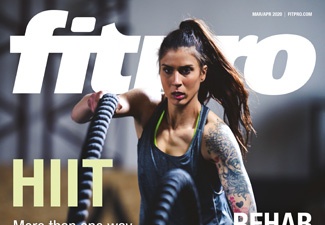Magazine References
Mar – Apr 2020

Pg 12-13
References
- Karageorghis, Costas I; Jones, Leighton; Low, Daniel C, Relationship between exercise and heart rate, Research Quarterly for Exercise and Sport, 2006. Read this article at http://goliath.ecnext.com/coms2/gi_0199-5641406/ Relationship-between-exercise-heart-rate.html#abstract Karageorghis, Costas I; How does music aid athletic performance?, runningforwomen.com. Read this article at http://www.running4women.com/search_results.php?article_id=126 Karageorghis, Costas I; Music increases sports performance by 20 per cent, Brunel University West London, 2005. Read this article at http://www.brunel.ac.uk/news/pressoffice/pressreleases/2005/cdata/october/Costas+music
- Szabo A1, Small A, Leigh M. The effects of slow- and fast-rhythm classical music on progressive cycling to voluntary physical exhaustion. J Sports Med Phys Fitness. 1999 Sep;39(3):220-5.
- Tenenbaum, G., Lidor, R., Lavyan, N., Morrow, K., Tonnel, S., Gershgoren, A., Meis, J., & Johnson, M. (2004). The effect of music type on running perseverance and coping with effort sensations. Psychology of Sport and Exercise, 5(2), 89–109. https://doi.org/10.1016/S1469-0292(02)00041-9
- Malcolm Budd Music and the Emotions: The Philosophical Theories, PUBLISHER: Routledge London:1985
- Multiple Components of the Perception of Musical Sequences: A Cognitive Neuroscience Analysis and Some Implications for Auditory Imagery Berenice Carroll-Phelan, Peter J. Hampson Music Perception: An Interdisciplinary Journal, Vol. 13 No. 4, Summer, 1996; (pp. 517-561) DOI: 10.2307/40285701
- Berlyne, D. E. (1971). Aesthetics and psychobiology. Appleton-Century-Crofts. 2020 American Psychological Association.
Pg 14-17
References
- van Hecke O., et al., (2013). Chronic pain epidemiology and its clinical relevance. Br J Anaesth. 111,13–18.
- Mills S.E.E, et al., (2019). Chronic pain: a review of its epidemiology and associated factors in population-based studies, (2019). Br J Anaesth. 123, (2), 273-283.
- Brinjikji W., et al., (2015). Systematic Literature Review of Imaging Features of Spinal Degeneration in Asymptomatic Populations. American Journal of Neuroradiology, 36 ,(4), 811-816.
- Bedson J. & Croft P.R., (2008). The discordance between clinical and radiographic knee osteoarthritis: a systematic search and summary of the literature. BMC Musculoskelet Disord, 9,116.
- Jensen M.C., et al., (1994). Magnetic resonance imaging of the lumbar spine in people without back pain. N Engl J Med. 33,1(2) ,69–73.
- Breivik, H., et al. (2006) Survey of Chronic Pain in Europe Prevalence, Impact on Daily Life, and Treatment. European Journal of Pain, 10, 287-333.
- Gaskin D.J. & Richard P. (2012). The economic costs of pain in the United States. J Pain, 13,8, 715-24.
Pg 22-25
References
- Gibala, G. (2017). The One Minute Workout. Vermilion: London. Laursen, P. & Bucheit, M. (2019). Science and Application of High-Intensity Interval Training. Human Kinetics: Champaign, Il.
- Rønnestad BR, Hansen J, Thyli V, Bakken TA, Sandbakk Ø. 5-week block periodization increases aerobic power in elite cross-country skiers. Scand J Med Sci Sports. 2016 Feb;26(2):140-6.
- Tabata I. et al. Effects of moderate-intensity endurance and high-intensity intermittent training on anaerobic capacity and VO2max. Med Sci Sports Exerc. 1996 Oct;28(10):1327-30.
Pg 26-27
References
- Principles of Rehabilitation Mary Kinch & Andrew Lambert Clinical Sports Medicine Third Edition Peter Brukner and Karim Khan).
- https://functionalanatomyseminars.com/functional-range-conditioning/
- https://www.trxtraining.co.uk/trx-academy
- https://www.viprfit.com/education.aspx
- http://plantarbeam.com/
- https://www.trxtraining.co.uk/why-trx.
- FRC – Functional Range Conditioning, Dr. Andreo Spina
- https://functionalanatomyseminars.com/.
Pg 28-31
References
- Szedlak C, Smith MJ, Day MC, Greenlees IA. Effective behaviours of strength and conditioning coaches as perceived by athletes. International Journal of Sports Science & Coaching. 2015 Oct;10(5):967-84.
- Becker AJ. It’s not what they do, it’s how they do it: Athlete experiences of great coaching. International Journal of Sports Science & Coaching. 2009 Mar;4(1):93-119.
- Childs ML. Perceived and preferred coach communication behaviors of cross-country athletes according to gender.
- Sartore-Baldwin ML. The professional experiences and work-related outcomes of male and female Division I strength and conditioning coaches.
- The Journal of Strength & Conditioning Research. 2013 Mar 1;27(3):831-8.
- Dawson AJ, Leonard ZM, Wehner KA, Gastin PB. Building without a plan: The career experiences of Australian strength and conditioning coaches. The Journal of Strength & Conditioning Research. 2013 May 1;27(5):1423-34.
- Greenleaf C, Gould D, Dieffenbach K. Factors influencing Olympic performance: interviews with Atlanta and Negano US Olympians. Journal of applied sport psychology. 2001 Mar 1;13(2):154-84.
- Stewan C, Taylor J. Why Female Athletes Quit: lmplications for Coach Education.
- Schinke RJ, Battochio RC, Dubuc NG, Swords S, Apolloni G, Tenenbaum G. Understanding the adaptation strategies of Canadian Olympic athletes using archival data. Journal of clinical sport psychology. 2008 Dec 1;2(4):337-56.
- Yang G, Schinke RJ, Dong D, Lu C, Si G, Oghene P. Working with Chinese Olympic athletes in their national sport system: From the conceptual to a proposed research–practice dialectic. International Journal of Sport and Exercise Psychology. 2016.
- Shacham S. A shortened version of the Profile of Mood States. Journal of personality assessment. 1983 Jun 1;47(3):305-6.
- Curran SL, Andrykowski MA, Studts JL. Short form of the profile of mood states (POMS-SF): psychometric information. Psychological assessment. 1995 Mar;7(1):80.
- Reilly T. The menstrual cycle and human performance: an overview. Biological rhythm research. 2000 Feb 1;31(1):29-40.
- Côté J, Gilbert W. An integrative definition of coaching effectiveness and expertise. International journal of sports science & coaching. 2009 Sep;4(3):307-23.
- Bompa TO, Haff GG. Periodization. Theory and methodology of training. 2009;5.
- Bass BM, Riggio RE. Transformational leadership. Psychology press; 2006 Aug 15.
- Smith V, Moore EW. Strategies to Increase Athletes’ Transformational Leadership Behaviors During Strength and Conditioning Sessions. Strength & Conditioning Journal. 2019 Apr 1;41(2):31-7.
- Avolio BJ. Full leadership development: Building the vital forces in organizations. Sage; 1999 Mar 11.
- Bandura A. Self-efficacy: toward a unifying theory of behavioral change. Psychological review. 1977 Mar;84(2):191.
- Fleming S, Hardman A, Jones C, Sheridan H. ‘Role models’ among elite young male rugby league players in Britain. European physical education review. 2005 Feb;11(1):51-70.
- Officer SA, Rosenfeld LB. Self-disclosure to male and female coaches by female high school athletes. Journal of Sport and Exercise Psychology. 1985 Dec 1;7(4):360-70.
- Lyle J. Sporting success, role models and participation: A policy related review. Edinburgh: sportscotland; 2009 Jan 1.
- Weinberg RS. Goal setting in sport and exercise: research and practical applications. Revista da Educação Física/UEM. 2013 Jun;24(2):171-9.
- Turner B. Factors Related to Preferences of Female Collegiate Volleyball Players’ Coaching Style. Robert Morris University; 2015.
- Deci EL, Ryan RM. The” what” and” why” of goal pursuits: Human needs and the self-determination of behavior. Psychological inquiry. 2000 Oct 1;11(4):227-68.
- Erickson K, Côté J. A season-long examination of the intervention tone of coach–athlete interactions and athlete development in youth sport. Psychology of sport and exercise. 2016 Jan 1;22:264-72. Psychology of sport and exercise. 2016 Jan 1;22:264-72.


